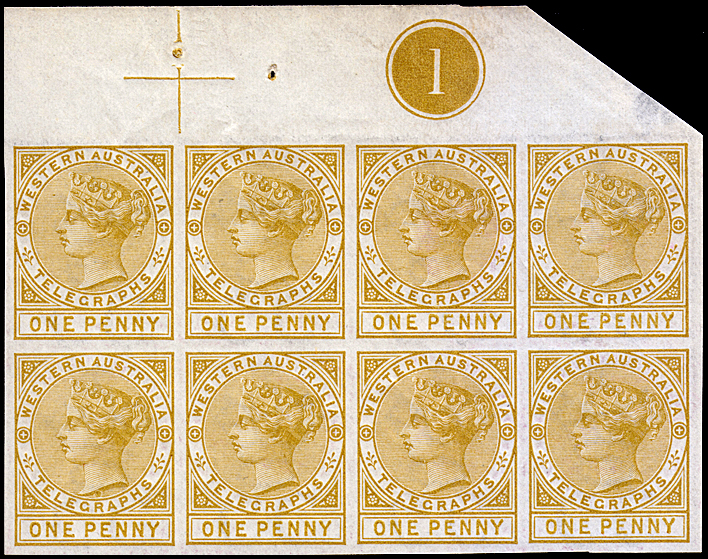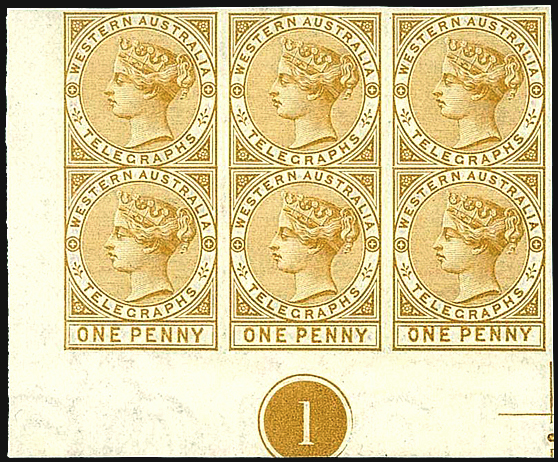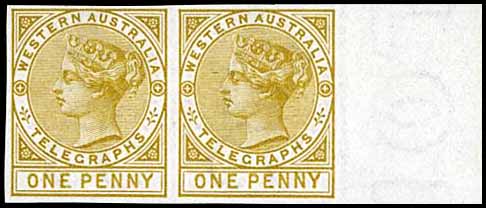The special telegraph stamps.
- Australia 1901-1988
- New South Wales
- Queensland
- South Australia
- Tasmania
- Victoria
- Western Australia
- International
- Special aspects
The stamps designed expressly for use for telegraph purposes in W.A. are described as follows:
- Background to the issues;
- Production;
- Use for postage.
In July 1878, an order was placed with the Crown Agents to supply Telegraph forms and Telegraph stamps. No legislation to authorise the use of stamps to pre-pay telegraph charges had been passed although the pre-stamped form had been issued in Victoria in 1873 and New South Wales had issued its Telegraph Stamps in 1871. It may therefore have felt like the "proper thing to have".
The Crown Agents had to have designs for the images on the form and for the stamps prepared and plates made. Pope (1979) gives details of these developments (p. 256-7). The Telegraph form with the pink indicium is discussed elsewhere.
The Government Gazette for 22 April 1879 included the following announcement:
Notice is hereby given that impressed stamp telegraph message forms and adhesive telegraph stamps, which may be used in payment for telegraphic messages, have been obtained from England and may be procured at the General Post Office and the Post and Telegraph Offices throughout the Colony.
The critical words in this announcement are "may be used". There was no requirement for the use of the stamps. Consequently people decided it was simply more straightforward to pay the costs in cash and Telegraph Officers were also satisfied with that type of transaction. There was also no place on the later transmission forms (without the embossed image) to place the stamps and there does not appear to have been any requirement for the public or for the Telegraph Officer to place any stamp purchased on the telegraph transmission form.
The denominations for the two stamps are interesting when interpreted against the scale of charges for telegrams.
- The 1d is understandable - it was used to pay the cost of words additional to the basic 10 words.
- There would have been little reason to have a 6d denomination.
- Possibly a 1/- denomination would have been useful because the rate for a telegram of 10 words sent within W.A. was 1/-.
In those still early days of telegraphic communication in Western Australia, the use of a higher rate 2/- telegram, at least from the public, would have been a rare occurrence - even allowing for a double rate for a telegram being sent out of hours or on a Sunday.
| De La Rue took a transfer from the original design of the Queen's head to form the die. It was deemed to be necessary to distinguish stamps used for Telegraph revenue from those featuring the swan which were used for postal revenue.
The space for the value was left blank so that a forme with either denomination could be inserted for the printing. Die proofs were taken on glazed card. The earliest recorded before hardening the dies was taken on 21 December 1878 - there being two known examples. Another master die proof is dated 23 December. |
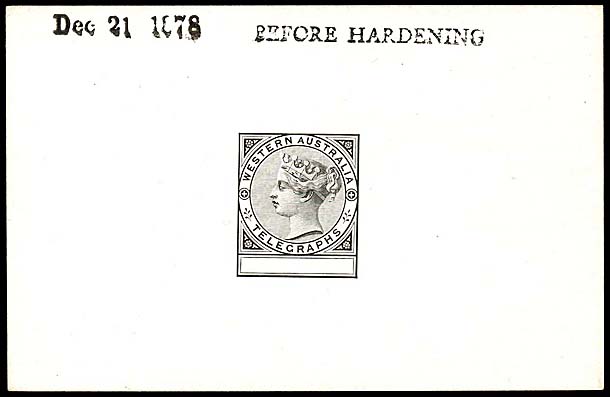 Die proof dated 21 December 1878. Status Auctions 2008 Sale 249 Lot 1649. A second example is distinguished by a faint comma after "21", an incomplete right upright for the "N" and a more complete "G". |
| After the Master die was completed on 24 December, a single proof was taken - printed in black on glazed card (60 × 90 mm) and marked accordingly. It was also initialled. | 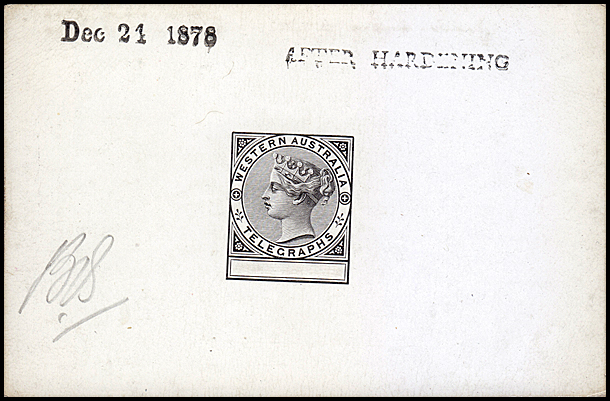 Provenance: Lord Vestey. Spink 19 May 2015 (Sale 15024), Lot 662. |
| There is one example of the finished die proof mounted on card.
Prestige Philately 2006. |
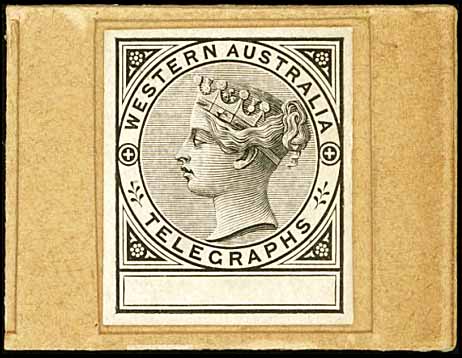 |
Printing was on sheets of 60 (10 rows of 6 stamps). A single imprimatur sheet was printed on paper with the Crown over CC watermark and gummed but left imperforate. From this single sheet of 60 plate proofs, the multiples recorded are:
|
||
|
1d bistre block of 8 from the top right corner showing the plate number and the alignment mark in the top margin. Printed on gummed watermarked paper. |
|
|
Block of 6 from the lower left corner showing the plate number, the alignment mark and part of the papermaker's watermark in the lower margin. | |
|
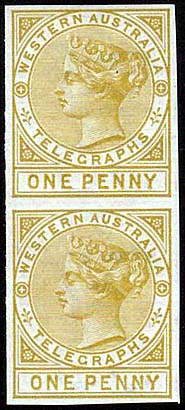 |
Vertical pair of 1d bistre. Status August 2008 Lot 1651. Another vertical pair was offered in the Spink Sale 4028 Lot 1857 (Provenance: Ron Butler). |
| There were two printings of the 1d stamp - both being made on Crown CC watermarked paper in sheets of 60.
The first printing - possibly in January 1879 (invoiced A second printing - in February 1879 - produced Hence the 1d perf 12½ stamps are more difficult to find.
|
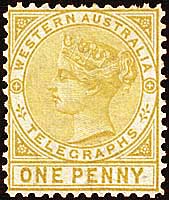 Unused 1d bistre perf 12½ |
| There was only one printing of the 6d lilac - of 25,200 stamps also on Crown CC paper and perforated 14. | 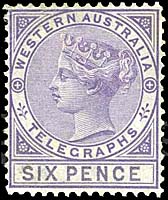 Unused 6d lilac. |
Multiples. Almost all of the known telegraph stamps are singles. The only recorded multiples are:
|
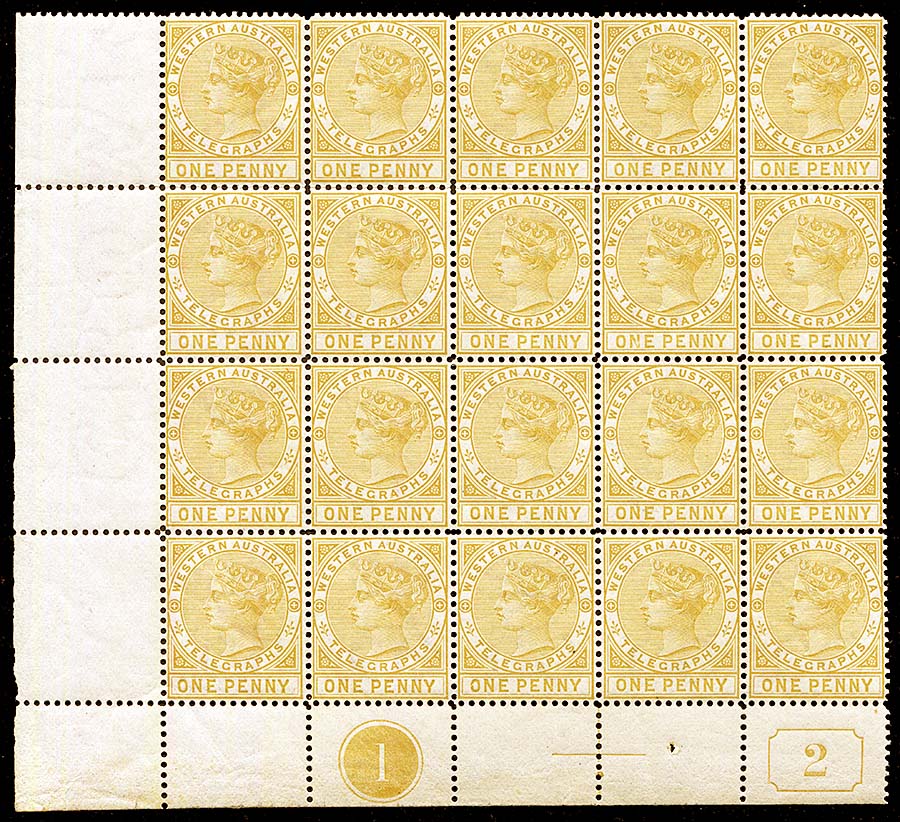 |
1879 1d bistre lower left corner Plate 1 block of 20 of 4 rows of 5 stamps. Incorporates the horizontal guideline and printers reference No. "2" in rectangular frame.
|
Marginal block of 6 of the 1d. Provenance: the Australia Post archival sale, February 1987 Lot 100.
Ace Auctions, March 2021, Lot 835. |
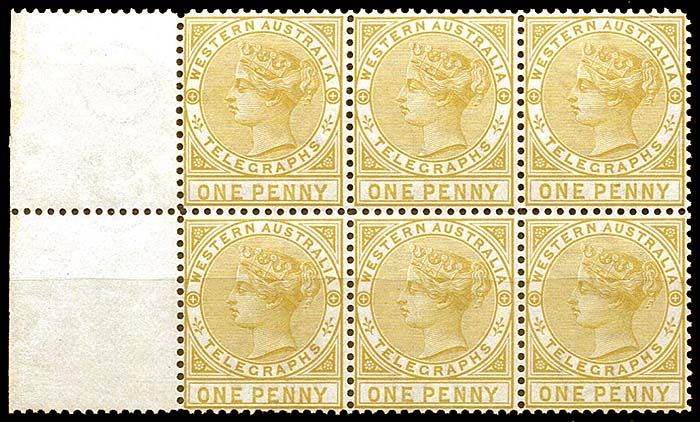 |
Blocks of 4 of the three perforation formats. Spink May 2015 Lot 664. Provenance: Vestey Collection. |
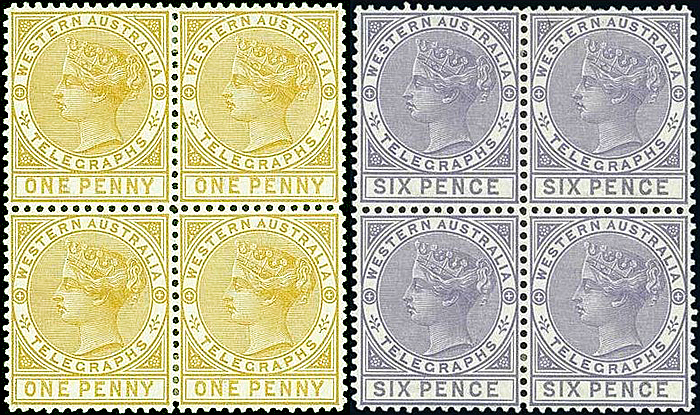 |
Plate 2 block of three The stamp at the top left has a slight hinge mark otherwise MUH. |
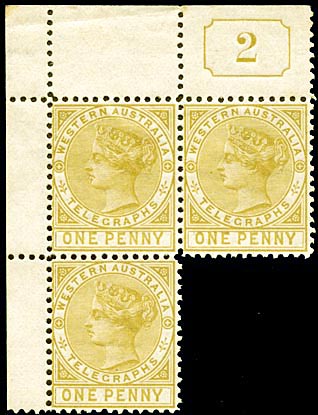 |
The question soon arose as to whether postage stamps could be used to pay telegraph charges as was the case in Victoria. Postmaster-General Helmich could see no reason why not. So, with the approval of the Governor, a gazette announcement of 7 February 1882 simply added the line "1/- adhesive telegraph message stamps" to the previous (February 1979) announcement for Telegraph stamps being used "in payment for telegraphic charges". There were, of course, no 1/- Telegraph adhesive stamps and so, by a de facto arrangement, the 1/- postage stamps were legitimised for telegraphic payments.
The Telegraph stamps were not selling and Helmich pointed out to the Governor that the 1879 introduction of the scheme to use Telegraph stamps to pay charges was not really working: "it has proved to be wholly inoperative in consequence of the public declining to avail themselves of the charge".
On 18 January 1886, the possibility of requiring telegram charges to be paid for with stamps began to be discussed. One argument in favour of this approach was that the system "is in force in England and in some neighbouring colonies". Public resistance was however a significant factor to be recognised and so that idea was quickly suspended.
Some members of the public capitalised on the reverse strategy - using the telegraph stamps to pay postage. Hence the 1d Telegraph Stamp was authorised for postal use from 25.10.1886. Postal use of the 6d was not specifically authorised but it was accepted.
|
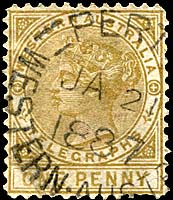 21 January 1887 at Perth. Early usage - less than 3 months after the decree. Perf 14 - 1st printing. |
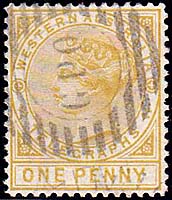 Perf 14 - 1st printing. G.P.O. cancellation. |
|
| Perf 12½ (2nd printing). | 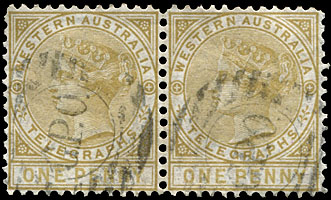 Very scarce pair - used at the GPO. |
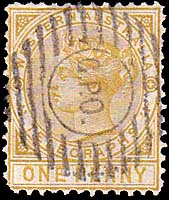 Single used at the GPO. |
|
| Without explicit authorisation, the 6d was also used postally. The only known example has an Albany postmark for November 1885. | 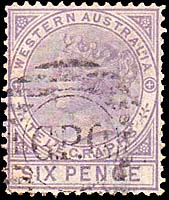 Postally used 6d lilac with a GPO cancellation. |
||
There may also be another reason for the October decree apart from the public's innovation. In that month, there were simply no 1d adhesive postage stamps in stock - although there was a sufficient supply of 6d postage stamps. This situation would therefore explain why the 1d Telegraph stamp was mentioned in Helmich's announcement and not the 6d Telegraph stamp.
Stamps are known with date stamps ranging from 1886 to 1888 although later dates are possible as the stamps were never withdrawn.
The Stamp Collector issue No. 25 of 1933 also gives a review of the Telegraph Stamps of WA.
